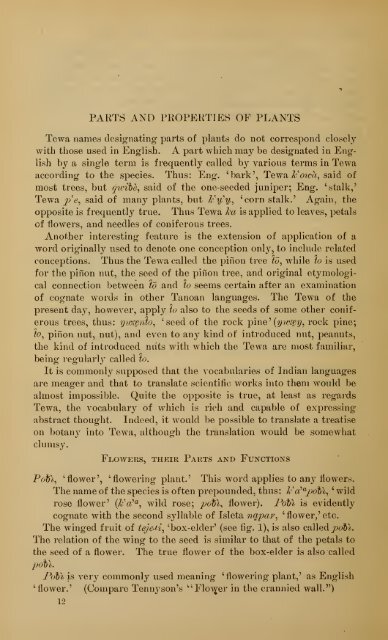Untitled - Smithsonian Institution
Untitled - Smithsonian Institution
Untitled - Smithsonian Institution
You also want an ePaper? Increase the reach of your titles
YUMPU automatically turns print PDFs into web optimized ePapers that Google loves.
PARTS AND PROPERTIES OF PLANTS<br />
Tewa names designating parts of plants do not correspond closely<br />
with those used in English. A part which may be designated in English<br />
by a single term is frequently called by various terms in Tewa<br />
according to the species. Thus: Eng. 'bark', Teyf a, k'^owa, said of<br />
most trees, but qivibe^ said of the one-seeded juniper; Eng. 'stalk,'<br />
Tewa ^V', said of many plants, but Fii'ii, 'corn stalk.' Again, the<br />
opposite is f i-equently true. Thus Tewa ka is applied to leaves, petals<br />
of flowers, and needles of coniferous trees.<br />
Another interesting feature is the extension of application of a<br />
word originally used to denote one conception onl}'^, to include related<br />
conceptions. Thus the Tewa called the pifion tree to, while to is used<br />
for the pinon nut, the seed of the pifion tree, and original etymologi-<br />
cal connection between to and to seems certain after an examination<br />
of cognate words in other Tanoan languages. The Tewa of the<br />
present day, however, apply to also to the seeds of some other conif-<br />
erous trees, thus: yws^fiio, 'seed of the rock pine<br />
'<br />
(??mj^7?, rock pine;<br />
to, pinon nut, nut), and even to any kind of introduced nut, peanuts,<br />
the kind of introduced nuts with which the Tewa are most familiar,<br />
being regularly called to.<br />
It is commonly supposed that the vocabularies of Indian languages<br />
are meager and that to translate scientific works into them would be<br />
almost impossible. Quite the opposite is true, at least as regards<br />
Tewa, the vocabulary of which is rich and capable of expressing<br />
abstract thought. Indeed, it would be possible to translate a treatise<br />
on botany into Tewa, although the translation would be somewhat<br />
clumsy.<br />
Flowers, their Parts and Functions<br />
Poil, 'flower', 'flowering plant.' This word applies to any flowers.<br />
The name of the species is often propounded, thus: k'a''^j)obl, ' wild<br />
rose flower' {Jca''^, wild rose; potl, flower). PoVi is evidently<br />
cognate with the second syllable of Isleta napap, 'flower,' etc.<br />
The winged fruit of teje^i, 'box-elder' (see fig. 1), is also called jr)6>&l.<br />
The relation of the wing to the seed is similar to that of the petals to<br />
the seed of a flower. The true flower of the box-elder is also called<br />
poVi.<br />
Pdb\ is very commonly used meaning 'flowering plant,' as English<br />
'flower.' (Compare Tennyson's "Flower in the crannied wall.")<br />
12

















